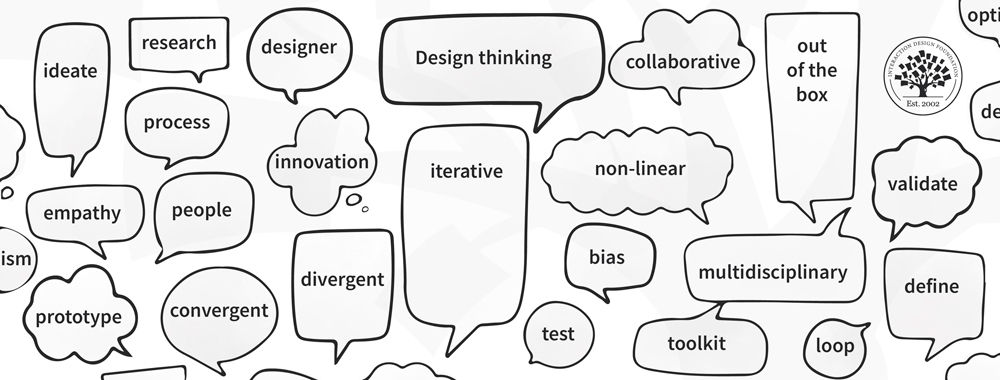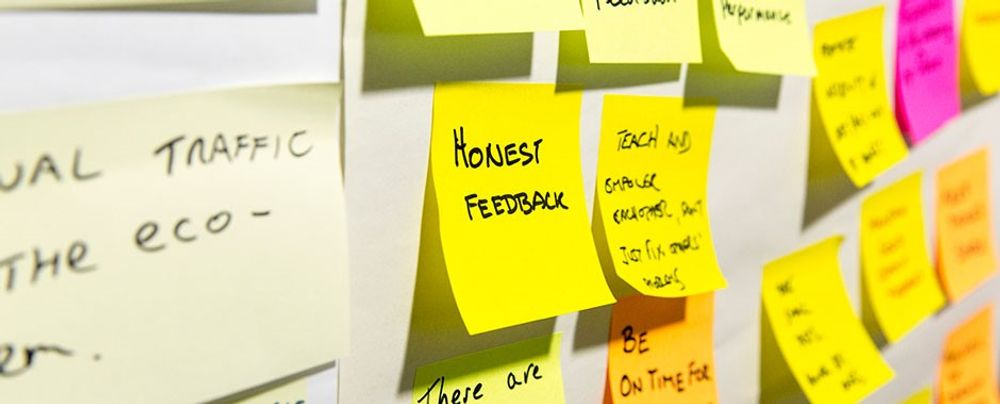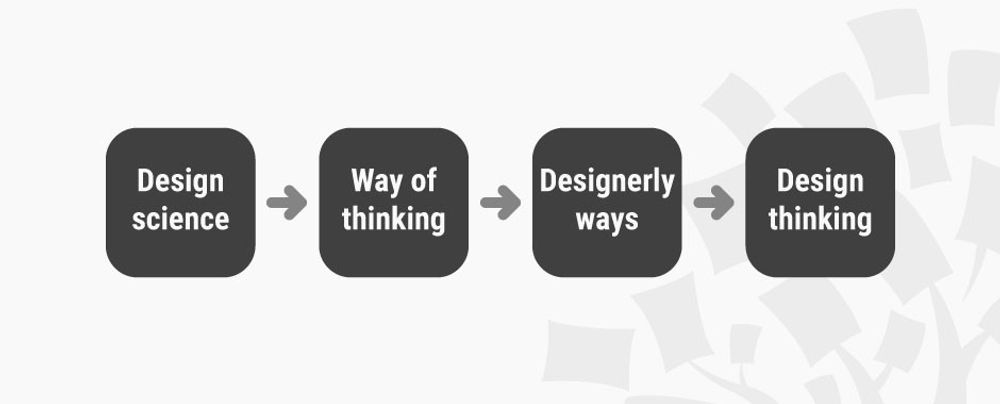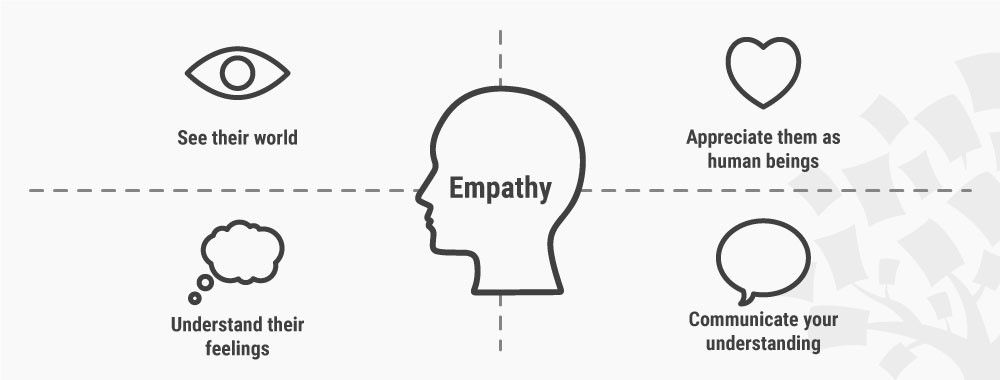Design thinking can transform companies, organizations and even lives, but it will fall short if you approach it in a superficial manner or without a solid understanding. The term “design thinking” is almost everywhere, and when a word is repeated so often, it risks becoming a buzzword. However, if you’re familiar with the designer’s mindset, you won’t lose sight of the intended meaning of design thinking and you will be able to fully harness its power.
A designer’s mindset includes qualities such as empathy, imagination, ambiguity, iteration, creativity, and problem-solving. Thinking like a designer involves being willing to fail early and often, learn and start again as many times as it takes. In short, designers need the optimism to try new ideas and the ability to make these ideas tangible. Only then can these potential solutions be evaluated and tested. Design thinking involves a perfect balance between analysis and imagination.
As you will see, design thinking is so much more than a buzzword. In this piece, you’ll find eight essential insights that will help you conquer design thinking and successfully apply it to your work and life.
1. Embrace the Fact that There Is No Single Definition of Design Thinking
Although there is no single definition of design thinking, if you grasp the basics of the designer’s mindset, you will be able to navigate its different interpretations and implementations.

There is no single definition of design thinking. However, the different interpretations are based on the same principles.
© Kilimanjaro STUDIOz via Unsplash, CC BY-SA 3.0
Each designer and company has developed their version of the design thinking method to adapt it to their needs. Let’s look at how Tim Brown, Executive chair of IDEO, defines design thinking:
“Design thinking is a human-centered approach to innovation that draws from the designer’s toolkit to integrate the needs of people, the possibilities of technology, and the requirements for business success.”
— Tim Brown, Executive chair of IDEO
IDEO interprets design thinking as a way of seeing the world, solving problems through creativity. However, a wide variety of design thinking frameworks and visualizations exist in the world today, and each typically contains between three and seven stages. No matter which framework you consider, the underlying principles remain the same.
In design thinking, you:
Approach the problem with empathy. The design thinking team puts the users’ needs at the center of the process.
Reframe the problem or challenge at hand. The team redefines the problem or challenge as many times as it takes to reveal the root problem.
Initially employ divergent styles of thinking. Quality is achieved through quantity.
Later employ convergent styles of thinking. After generating many ideas, the team chooses which ones to pursue.
Create and test prototypes. The team develops prototypes to make ideas tangible so they can be tested.
Iterate. The team can repeat all the previous processes in a different order at any time to keep refining the solution.
2. Design Thinking Is Not Only for Designers
Design thinking is not only for designers but also for any organization or individual—within any field—interested in a powerful approach to drive innovation that keeps people at the center of every process. Furthermore, design thinking methods and strategies belong at every level of a business.
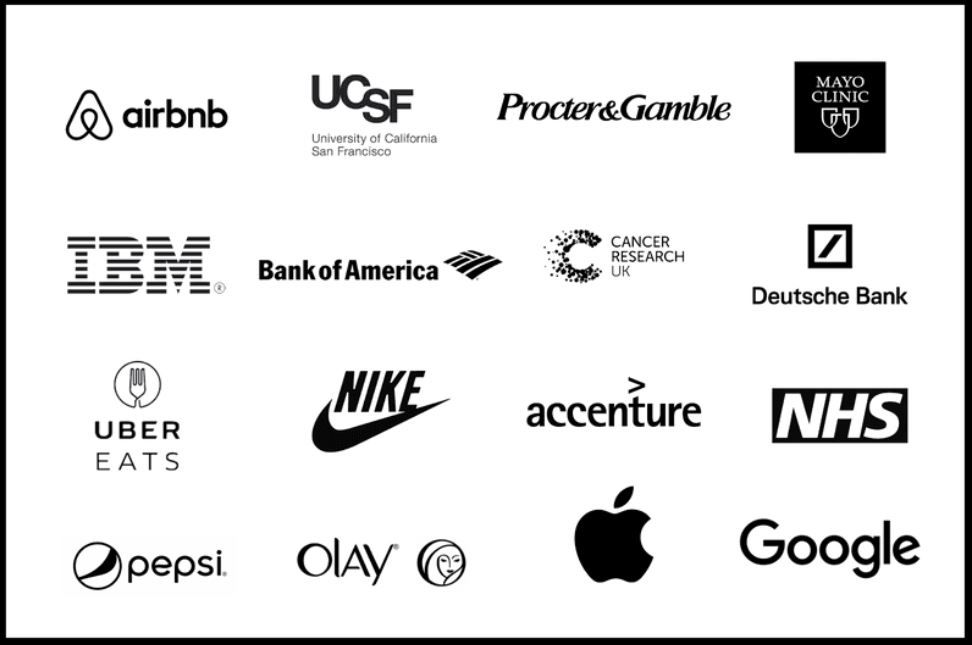
© Logos and brands are property of their respective owners, artwork by Design Thinkers Academy, London, Fair-use (Link)
The design thinking process has become increasingly popular over the last few decades because it was critical to the success of many high-profile, global organizations. This outside-the-box thinking is now taught at leading universities worldwide and is encouraged at every level of business.

Phil Gilbert, co-founder of IBM Design Thinking.
© Sandy Carson for The New York Times, Fair-Use (link)
You should follow this process in a collaborative, multidisciplinary team, and include people with different backgrounds and experiences.
Many people who have learned the basic concepts of design thinking have quickly adopted this approach to solve problems and deliver better results or products. While beginners can easily engage in design thinking processes, it takes time, practice and a solid foundation to truly master design thinking, and not only at an individual level but at an organizational level too. For design thinking to work successfully, its principles must be embraced by the culture of the organization, which include welcoming failure as a necessary part of the learning process and accepting risk.
3. Everything Starts with the Right Problem Statement
At the start of any project, you are usually given a problem to solve in the design brief. The first step for a successful design thinking process is to challenge the assumptions you were given to ensure you find the right problem to solve.
Humans are prone to see the symptoms without paying attention to the cause—the root problem. Imagine you were going to the doctor because you were feeling nauseous. Many conditions may cause nausea, from food poisoning to pregnancy. To treat you correctly, the doctor would need to figure out the cause, which you may not be able to identify at the time—because you’re not trained as a doctor. Usually, you would notice the symptoms, and then the doctor would use their expertise to diagnose the underlying cause and offer you a treatment—the solution—accordingly. As a designer, you should do the same thing, figure out the root problem your client needs to solve. This approach alone will make you stand out from many of your peers and take your work to the next level.
Make the discovery process your best friend. It’s not that people are purposely giving you the wrong problem to solve; no one—not even designers—can identify problems from the get-go. Use all the tools at your disposal, from surveys and interviews to eye-tracking techniques, to counteract your own—and your team’s—implicit biases and assumptions and identify the root problem. Keep this golden rule in mind: “Find out what users and clients mean.” Then you will be able to solve the correct problem.
However, the process to get there won’t be straightforward. Be prepared to go back and forth, diverge, generate multiple problem statements and keep iterating and testing. We know this might differ a bit from the preconceived idea people may have about progress, which would probably look like a straight line that goes from A, the problem, to B, the solution. Well, in reality, it might look more like the image below.
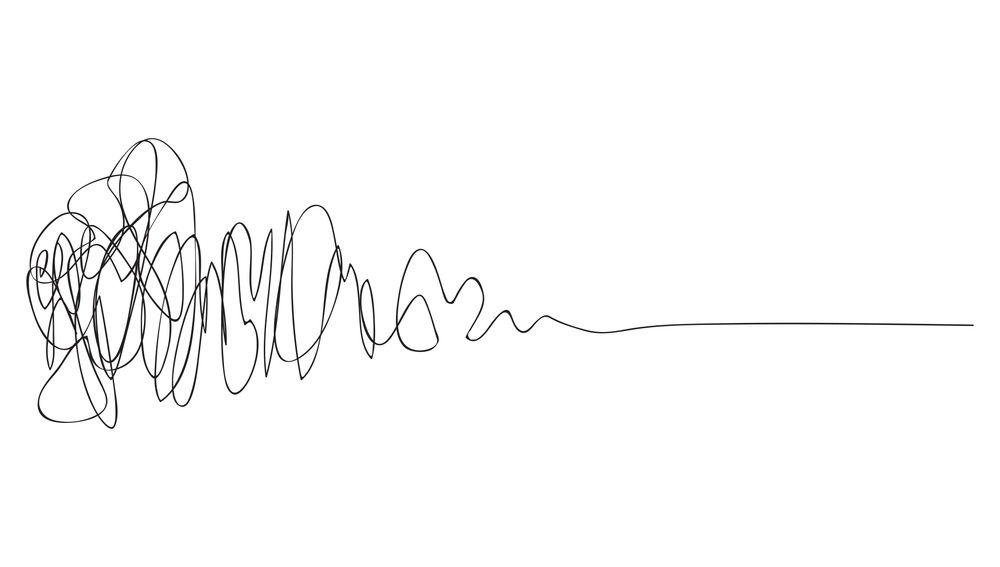
The design process isn’t a straight line. It’s a messy squiggly process that you must endure to gain clarity about the right problems to work with.
© Damien Newman, CC BY-NC-ND 3.0.
The sooner you get comfortable with this visual metaphor of progress, the less anxiety you will feel and the better work you will do. This metaphor represents design thinking at its best. It might be challenging to have this mentality in a traditional organization but think of yourself as an ambassador for design thinking.
4. Embrace the Fractal Nature of the Design Thinking Process
Let’s consider one of the most popular frameworks of design thinking, as proposed by the Stanford d.school: a non-linear, iterative process that consists of five phases: 1. Empathize, 2. Define, 3. Ideate, 4. Prototype and 5. Test. Seems pretty straightforward, doesn’t it? The tricky part is to truly understand—and execute—these stages in a non-linear order and an iterative manner. These two keywords might be the secret sauce for a successful design thinking process. As humans, we—or at least the non-quantum-physicists among us—understand time as a linear element to a certain extent. Therefore, we like ordered processes that go forward or backward, but with clear directions so we don’t get lost. Stop for a moment and reflect upon whether or not you are fully grasping the magnitude of the non-linear and iterative qualities. Think of it as a fractal. For our scope, let’s understand fractals as never-ending patterns. What happens if you think of these five stages as never-ending patterns? This approach would mean that each of these stages contains the five stages and so on.

© Mandelbrot set (fractal), Wikimedia Commons, Public domain
If you embrace the flexible nature of design thinking and view it as progress, you will get better results and enjoy the process. For example, the type of prototypes you create throughout the design thinking process will evolve with every iteration—from an initial simple sketch and paper prototypes to role-playing and fully functional digital prototypes. Similarly, the problem statement will evolve, and will likely be very different from when you started. You need to master the diverge-converge dance to become excellent at design thinking. And that is the beauty of it.
However, you have probably noticed the elephant in the room about the never-ending approach of design thinking. If this process is never-ending, how do we deliver finished products? How does it end?
5. Know When to End the Design Thinking Process
Here is the hard truth: no matter how much time a design team has, results will only seem to appear 24 hours before the deadline. That is the nature of the process. You can never reach perfection, but the more iterations you do, the closer you get. It takes an experienced leader to know when the resulting solution is the best possible, considering budget and time constraints. To execute the design thinking process correctly, you need to ensure it is feasible and viable. A solution is no good if it cannot be built with existing resources. Even if it is built, but cannot generate sufficient profits for a business, or is otherwise unsustainable, it will not survive. With practice, you will learn when you can transition from the design thinking process to the product development process. But even after you move on and launch the product or solution, it doesn’t mean that the design thinking process ends. You can continue to research and understand how to improve your solutions continuously. The beauty of digital products is that you can continue to deliver incrementally better experiences to your users even after they have the product in their hands.
6. Design Thinking Counteracts Human Biases
Design thinking is a fundamental methodology, but it should be used wisely. One of the things that makes design thinking a necessary tool for human-centered innovation is that it counteracts human biases, even implicit or unconscious ones. If you understand this fact, you’ll be able to take full advantage of this methodology and be in a great position to deliver outstanding results.
As humans, we learn from our past experiences and form specific patterns of thought, most of which we are not even aware of. As you know, innovation requires out-of-the-box thinking, and the only way to achieve it is to break these preconceived ideas and notions that we have formed. In other words, you need to break prejudices. Design thinking gives you a framework that lets you do precisely that, allowing you to do it in a collaborative environment. This collaborative dimension is the true power of design thinking and the secret ingredient for human-centered innovation.
“Discovery consists of seeing what everybody has seen and thinking what nobody else has thought.”
— Albert Szent-Györgyi, Winner of the Nobel Prize in Physiology or Medicine in 1937
Design thinking is not a painless process; it pushes you and your team to find the best solution, not the easiest one. As a philosophy, it guides you to challenge your own way of thinking and reassess every step of the way to—in the end—deliver world-changing innovations.
7. Design Thinking Provides a Framework to the Innovation Process
Design thinking has become the common approach to human-centered innovation, “innovation” being the keyword. We live in a world where the only constant is change, and thus innovation is essential to tackle the new challenges we face as a society. Think back to when you were a child; what were your needs back then? Do you have the exact same needs now? Probably not. Luckily, all experiences in your life have helped you learn new tools to overcome new challenges, and your ability to do that successfully may have a lot to do with how self-fulfilled you feel. We can extrapolate this reasoning to a larger scale. As a society, we need to innovate to overcome emerging challenges such as the aging population, climate change and so on. We need to innovate to survive. Design thinking helps us innovate, and therefore, we need to take it seriously.
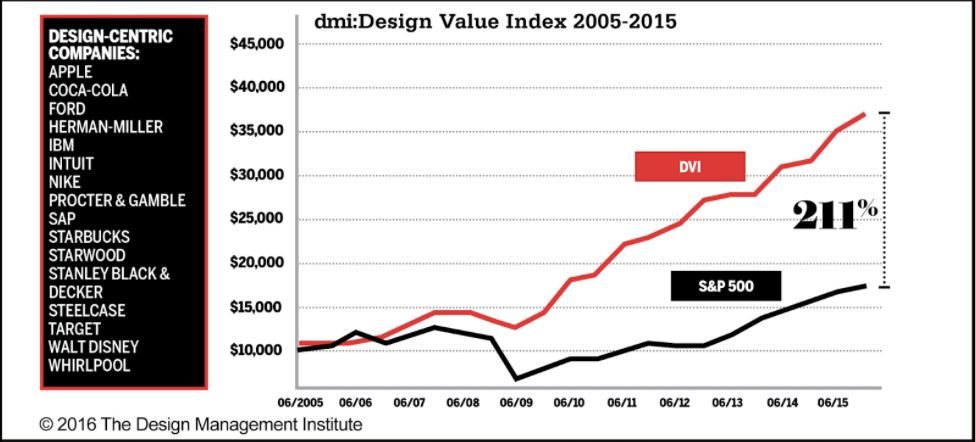
According to the Design Management Institute, design-driven companies—like Apple, Nike, and Walt Disney, among others—outperform the S&P 500 by 219%. Companies and organizations that operate with a design thinking approach—and do it the right way—are able to get ahead in the innovation process and thus, adapt to the rapidly-changing world we live in and stay relevant. They are constantly iterating their products to make sure they are still fulfilling the needs of their users and tweaking them, so they do it even better and better.
© Design Management Institute, Fair Use (Link)
“If you have always done it that way, it is probably wrong.”— Charles F. Kettering, American engineer, founder of Delco, and head of research at General Motors from 1920 to 1947
8. Design Thinking Takes Time to Master
You can’t learn design thinking in a day, and that’s OK. You have probably seen many one-day workshops on design thinking. These workshops can be great introductions to the topic, but keep in mind that learning design thinking takes time and effort. For instance, you can do a one-day running training session, but you wouldn’t expect to win a marathon right after that, especially without previous experience. The same happens with design thinking. It even takes designers a long time to master this methodology.

In the first movie of the Karate Kid trilogy, Mr. Miyagi tries to teach his young, ambitious student that no one becomes excellent overnight. He has to put in the effort and be patient because mastery cannot be rushed.
© Karate Kid movie (1984), Columbia Pictures (Sony Pictures Entertainment) via gfycat, Fair-use (Link)
Design thinking is not exclusive to designers. However, beginners might be more likely to misuse it, and that’s just because mastering design thinking takes practice. So, take the time to truly understand what design thinking is for and which purpose it serves. Then, you will be able to bring extra value to the process by offering your unique point of view and generating successful results.
If you’d like to learn more about design thinking, enroll in the Design Thinking: The Ultimate Guide course! You will learn how to apply design thinking to your problems to generate innovative and user-centric solutions.
Where to Learn More
Design Thinking: The Ultimate Guide is a 6-week course designed for anyone who wants to infuse an approach to innovation that is powerful, effective and broadly accessible, one that can be integrated into every level of an organization, product, or service to drive new alternatives for businesses and society. This course is ideal for designers of all levels, project managers, entrepreneurs, marketers, stakeholders, and anyone interested in learning this innovative problem-solving approach.
The course Design Thinking: The Ultimate Guide is now open for enrollment and is included in your IxDF membership.
Still undecided? You can sneak a peek into lesson 1. Simply scroll down the page and hit the preview links when you see them!
To become a member, sign up here.
Image
Hero Image: © rawpixel and Freepik, CC BY-SA 2.0
